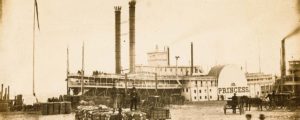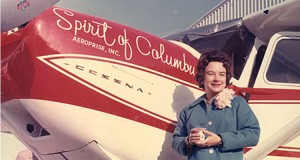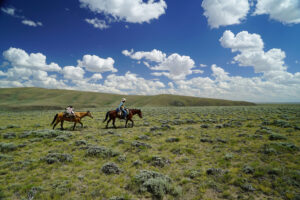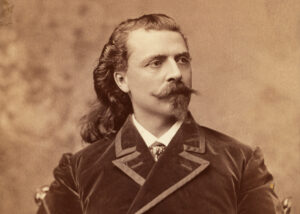While her husband struggled to find gold, Martha Maxwell discovered riches in Rocky Mountain fauna and fame as a skilled naturalist and taxidermist.
In the winter of 1860, James A. Maxwell of Baraboo, Wisconsin, sought to cure his financial woes amid the gold diggings of what would soon be Colorado Territory. He did not expect his 4-foot-11 wife, Martha, to come along. The 48-yearold Maxwell knew that 29-year-old Martha had enough to do at home. She was mother of their own 2-yearold daughter and stepmother to his six other children, four of them still at home. She also fed and cared for his aging father and a hired man. But Martha was not the stay-at-home kind. And when James clucked his team into motion on February 21, 1860, headed for Pikes Peak, Martha sat with her husband and three—soon to be four—young men in the wagon. Despite the vocal disapproval of family and friends, she left her tearful daughter, Mabel, in the care of her mother and faced west.
An enthusiastic traveler, Martha cooked for six, slept soundly and took turns driving. By May 7 they were on the raw streets of year-old Denver with hundreds of other gold seekers. And, like many, they quickly left for the diggings near Central City. Martha immediately contacted a widow she had known in Wisconsin, and the two women paid $100 for a lot on New Nevada Road and the hewn logs with which to build a house. By early June, the two-story combined boarding house, restaurant and home was complete— except for roof and windows. Martha was taking in washing and mending and baking pies. Determined to prove she would not be a burden, she kept her finances apart from her husband’s. Little did Martha know she would soon discover her life’s work in a field that was a far cry from a woman’s usual frontier station and go on to achieve national fame.
Martha’s marriage to the much older James Max- well had been one of convenience, not passion. Nine years earlier she had fallen in love with a fellow student during her 15 months of study at Ohio’s Oberlin College. Her parents made great sacrifices to pay for the schooling, and Martha responded, excelling at history, algebra, Latin, geometry and especially botany. She was devastated in the fall of 1852 when the money ran out.
At school Martha had grown close to a young man who promised to write and make plans for their future. She returned home to teach, write to her young man and hope to resume her education. Months went by without the anticipated letters. Then a prominent citizen of Baraboo, the recently widowed James Maxwell, asked Martha to chaperone his two oldest children at college. In return he would pay her school expenses. Grateful to be studying again, she developed her artistic talents and knowledge of nature.
Some months later, she was astonished when Maxwell wrote that he wanted to marry her. She did not answer for a month and then protested she was not the person he imagined. He persevered. Weeks passed, and no letter from her college paramour arrived. Maxwell was patient, reassuring, considerate. Her young man was silent. At length she accepted Maxwell’s proposal. They married on March 30, 1854.
A few days later several letters arrived addressed to Martha Dartt (her maiden name). Her sister Mary described later how Martha paled when she read one, crushed it into her pocket and walked away. It was years before Martha confided in Mary; these were the long-delayed letters from her Oberlin man, telling her he wanted to spend their lives together. But she was already Mrs. James A. Maxwell. She chose to swallow her heartbreak and face what had to be.
And now in the goldfields, she was determined to exert her independence by making money of her own. By August 1860 she had sold her interest in the first boardinghouse and opened another in Nevada City. James Maxwell and his sons took time off from prospecting to help erect the 22- by 40-foot building. Meanwhile, Martha filed the first of 20 mining claims. In spite of hard times in 1861, she also bought a ranch claim and one-room log cabin east of Denver. Her days disappeared in a fog of washing, cooking, cleaning and caring for boarders. By their fourth month in the Pikes Peak region, her scrupulously kept accounts, crediting James for his contributions, showed her personal worth at $1,583.35.
A few months later their boardinghouse/home was a pile of ashes, along with some 50 other buildings, after fire ravaged the town. Lacking even personal belongings, they left Nevada City and traveled to their claim on the plains, which they found occupied by claim jumpers. An arbitration court ruled in their favor, but one of the squatters, a German, refused to vacate the cabin. When Martha went over to insist he vacate, she became distracted and increasingly fascinated by what the man was doing—preserving and mounting birds. The art of taxidermy was new to her, but the more she looked, the more she wanted to know. She offered the man $10 a lesson to teach her, but he refused. Unable to convince him otherwise, Martha made her own plans. She waited until the squatter left for town, gained entrance by dismantling the door frame and deposited his belongings on the prairie —after a careful study of his works in progress.
Martha told her family she wanted to learn to preserve the birds and animals of Colorado. If only she could learn how. However, in 1862 it was all she could do to help James coax a crop from the land. Then word came from Baraboo that Martha’s mother had fallen too ill to care for Mabel, now age 4. Thin and exhausted, Martha went home to a daughter who had forgotten she existed.
The years of separation had created lasting distance between mother and daughter, made worse when Martha again disappeared from her daughter’s life to spend months in a sanitarium, recovering her health. James kept urging her return to Colorado Territory. Martha kept delaying; her feelings about James were mixed, and she was taking lessons in taxidermy, an art that would dominate the rest of her life.
In 1868 James finally convinced Martha to collect daughter Mabel and return to Colorado, where he was now established in Boulder. Once settled, she began to collect the territory’s flora and fauna. James was supportive, and he and neighborhood boys obtained specimens for her. But Martha grew impatient. She bought her own gun and began to practice, and even though James teased her for aiming with her left eye, she soon matched him in marksmanship.
Martha seems hardly to have drawn a breath, as in August 1868 she had the family up in Middle Park of the Rockies on a collecting excursion. Loving the natural world as she did, she was in her element, taking such specimens as a lightning quick mountain chipmunk, tassel-eared squirrels and several birds. It was the first of several trips, and as the weather cooled, mountain showers were anything but pleasant. Clothes remained damp, boots were stiff with cold, the tent was often coated with frost, and wet wood made breakfast fires a chore to start. Martha was indifferent to the discomfort. Young Mabel hated it. The horseback rides up and back, with packhorses to lead, lasted several days. Mountain trails were steep, with frightening drops beneath the stirrups. Lightning and rain increased the danger, as streams rose and fords disappeared in foaming white water.
Yet that fall in Denver, the Colorado Agricultural Society’s third annual exhibition included Martha Maxwell’s 100- specimen collection of Colorado birds. It was the most anyone had seen in one collection, according to The Rocky Mountain News. What’s more, the birds were not sitting stiffly in lines on shelves. Martha had arranged them in lifelike positions on two large cottonwood shrubs. The newspaper named it the chief attraction in the room and praised the “skill and scientific attainment” of the lady from Boulder.
The species ranged from a hummingbird to an eagle, chicks to hawks, and were “in such natural positions,” said the judges, “as to almost deceive the eye.” They especially remarked on the lifelike settings. They awarded Martha top prize of $50 and a diploma. She was gratified, but she had always had a further goal in mind. Knowing her knowledge was incomplete, feeling her education inadequate, she wrote to the Smithsonian Institution in Washington, D.C. What ornithology texts did they recommend? Could they help her identify specimens? Moreover, would they pay a capable person to secure specimens for the museum?
Receiving a positive response, she kept enlarging her collection, traveling as far as Wyoming Territory and the Black Hills of Dakota, where she obtained a pronghorn antelope. She also mounted specimens for other people; money for this work was increasingly important, as James suffered financial failures. In 1869 she again exhibited at the Colorado Agricultural Society fair, and by then her collection had increased to 600 specimens. Weasels, deer, foxes, grouse, wolves and badgers joined the pronghorn, various reptiles and a dozen kinds of eagles and hawks. Again she won acclaim, and prominent men in Denver said they would pay for her to exhibit at a fair in St. Louis. Reaction there was better than words: Officials at Shaw’s Garden, precursor of the Missouri Botanical Gardens, offered her $600 for the specimens.
The decision was exceedingly difficult. The dollars could not pay for the labor and dedication collecting demanded. But it was hard cash, and that was scarce at home. She left her beloved specimens in St. Louis. With the money she bought a home on land at the mouth of Boulder Canyon. Then she began another collection.
Martha was now a professional, not a hobbyist. She and James built a small workshop on Boulder Creek, and Martha spent her days and part of her nights in toil, ignoring food, dress, family and the world outside her small kingdom. It was soon overflowing with the artifacts of her trade—clay, plaster, putty, hemp, wire, cotton, wool and hay; grasses and branches; a palette and brushes; nests and eggs; bottles of insects; reptiles; fossils; bones; heads and horns of buffalo, pronghorn and sheep; antlers; bird skins; glass eyes; ammunition and guns.
Skinning came first, whether bird or bison, and then came careful measurements—as many as 15 or 20—so she could create the right-sized “body.” Skinning and cleaning horns and hooves was heavy, disagreeable, sometimes smelly work, but Martha did it herself so she could closely study musculature. As she progressed, she hired a blacksmith to craft light iron frames, covered that with fabric to fill out the animals’ shapes, attached the real leg bones and sewed the skin over all. It was a method she developed by trial and error in the late 1860s. As late as 1873 the leading school of taxidermy in the East was still stuffing animal skins with straw. They would come to use Martha Maxwell’s refined approach, but given her isolation at the foot of the Rockies, her innovations went unrecognized.
Less than a year after selling her first collection, she was again at the Denver exhibition. This time several snakes, a black bear and a 6½-foot standing grizzly joined the other specimens. Martha expressed love for her birds and animals; daughter Mabel hated them. She wrote later of her intense jealousy, believing her mother’s specimens stole the love she craved.
With her collection crowding them out of the house, family finances in dire straits and her unhappy daughter ready for college, Martha came up with a solution she expected would provide them both a place to live and needed income. She would open a museum. No mere sideshow, she wanted it to be a scientific institution, a place to teach natural science. But she was savvy enough to know it must include an element of fun and something exotic to attract a wider audience. She redoubled her efforts to obtain every Colorado species, widened her search to include minerals, fossils and Indian artifacts, and spent four months of 1873 scouring the West Coast, collecting everything from a shark’s jaw to redwood bark. The indefatigable woman also continued to collect for the Smithsonian and to learn from their experts.
The Rocky Mountain Museum opened in Boulder (they could not afford Denver) in June 1874. Writer Helen Hunt complimented Martha’s habitat groupings, while Ferdinand V. Hayden of the U.S. Geological Survey said it “excelled every other [museum] in the West” and ought to be connected with a university. But the museum did not make money. With the backing of substantial Boulderites, Martha moved the museum to Denver in the U.S. centennial year. Even though she and James slept on the floor and otherwise lived modestly, they still failed to make money. They were saved from financial despair when the committee in charge of Colorado’s exhibit for Philadelphia’s Centennial International Exposition asked her to be part of the state’s display.
For five years the nation had been preparing to celebrate its 100th birthday (see “Reckoning the West at the Centennial,” by Kevin L. Cook, in the June 2009 Wild West). The exposition centered on five large halls, a U.S. Government Building and a Women’s Pavilion. More than two dozen states erected their own structures. Martha’s display occupied an entire wall of the Kansas/Colorado building. No one had seen anything like her landscape of mountains and plains, including trees, rocks and a little stream that fed a small lake filled with aquatic life. The mountain, which included a cave, was busy with bears, pumas, deer, sheep, ground squirrels and other creatures. Buffalo, elk and pronghorn grazed the prairie. Out front Martha posted a small placard: WOMAN’S WORK.
Visitors were fascinated with the display, where a cougar leaped to kill a stag, a doe nuzzled her fawn and a fox peered down from a boulder. They were even more amazed that this small, modest and ladylike woman had shot most of the animals herself. Martha was constantly answering questions— Where did you find your specimens? What did you wear to hunt them?—and warding off those compelled to poke and prod to make sure the creatures were not alive. Reporters from leading magazines and newspapers kept her busy with interviews, one writer dubbing her “the Rocky Mountain Huntress.” Daily, for the six months the exposition was open, she stressed the scientific goals of her work.
And always before her was the practical goal of making money to keep her daughter in college. The Colorado committee was paying expenses, but she needed income, which she earned by selling photos, until management informed her they had exclusive rights.
Martha had achieved more fame than she could imagine, and scientists at the Smithsonian and elsewhere urged that her collection be permanently housed in some institution. “I feel my life has but just commenced,” she told sister Mary.
It must have seemed so. When two Washington, D.C., men paid her to exhibit in the nation’s capital, she expected it would be the first of many rewarding offers. But business in Washington proved so slow, she could not meet expenses. The Colorado committee was tardy with payments. She was left in discouraged indecision. James, back in Boulder, urged her to sell, give away or abandon the work he now referred to as “the elephant.”
In her remaining years, Martha would try every avenue to make her life’s work pay. Experts helped her publish catalogs of her exhibit, including a screech owl she’d discovered and scientists had named for her. (Martha was the first woman so recognized.) She and sister Mary wrote a book about her career, On the Plains and Among the Peaks, published in 1879 to high praise. Never idle, she studied at the Massachusetts Institute of Technology, exhibited in Philadelphia and tried unsuccessfully to establish a seaside resort/museum on Long Island. Struggling on alone, her life was cut short by ovarian cancer. Martha Maxwell died in her Brooklyn apartment on May 31, 1881. She was 49.
After Martha’s death, daughter Mabel at last came to appreciate her mother’s work. She contracted with J.P. Haskins of Saratoga Springs, N.Y., to store and/or sell the collection. He did exhibit it several times, and then stored it carelessly in a barn. In 1893 Martha’s sister Mary sought to have it moved to a suitable institution, but Haskins insisted on an exorbitant payment no one could provide, and the family gave up.
In the early 1900s Haskins occasionally exhibited the collection, but after he died, the specimens sat unprotected in a vacant lot. In 1920 Mary tried one last time to rescue the remaining pieces and donate them to the University of Colorado, which readily accepted them. However, examination proved the remaining useable pieces too few to convey Martha Maxwell’s vision of Rocky Mountain creatures enjoying their natural habitat, so the project was dropped.
Today her name is little known, but her methods and artistic placement of specimens in their natural habitat are standard practice in the world’s museums.
Colorado writer Nancy M. Peterson is a longtime contributor to Wild West. Recommended for further reading: Martha Maxwell: Rocky Mountain Naturalist, by Maxine Benson.
Originally published in the June 2011 issue of Wild West. To subscribe, click here.




